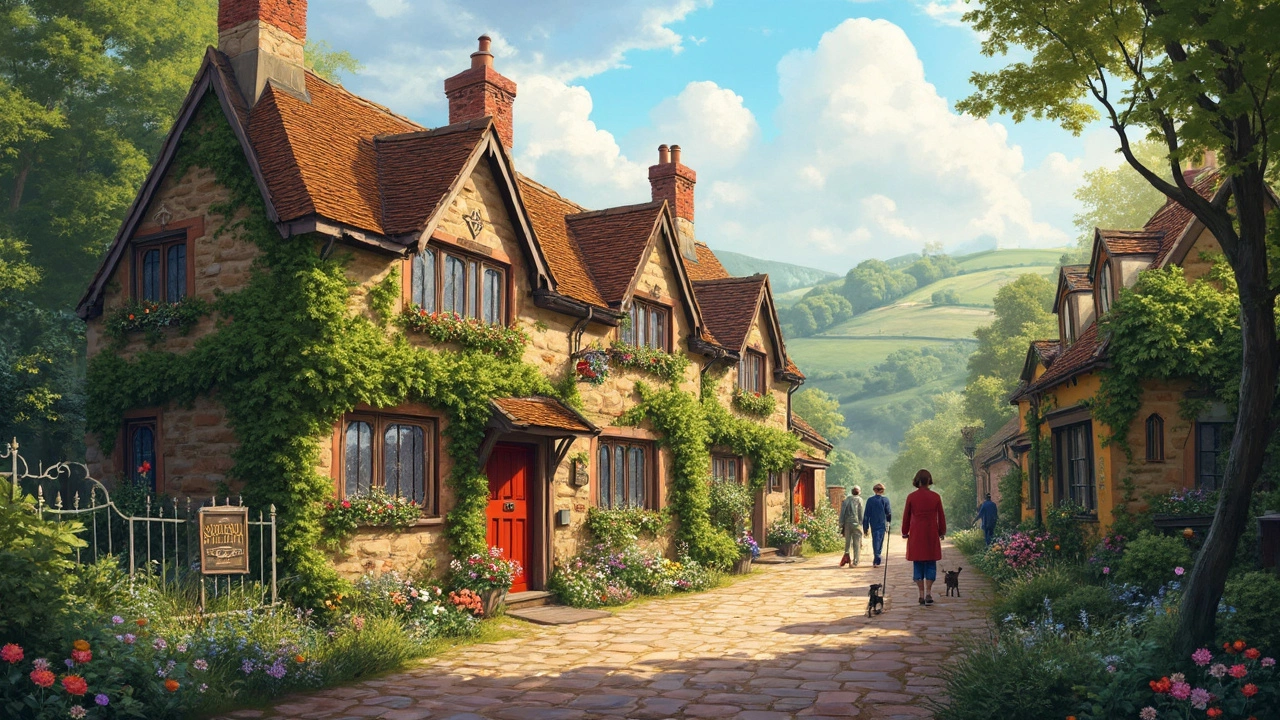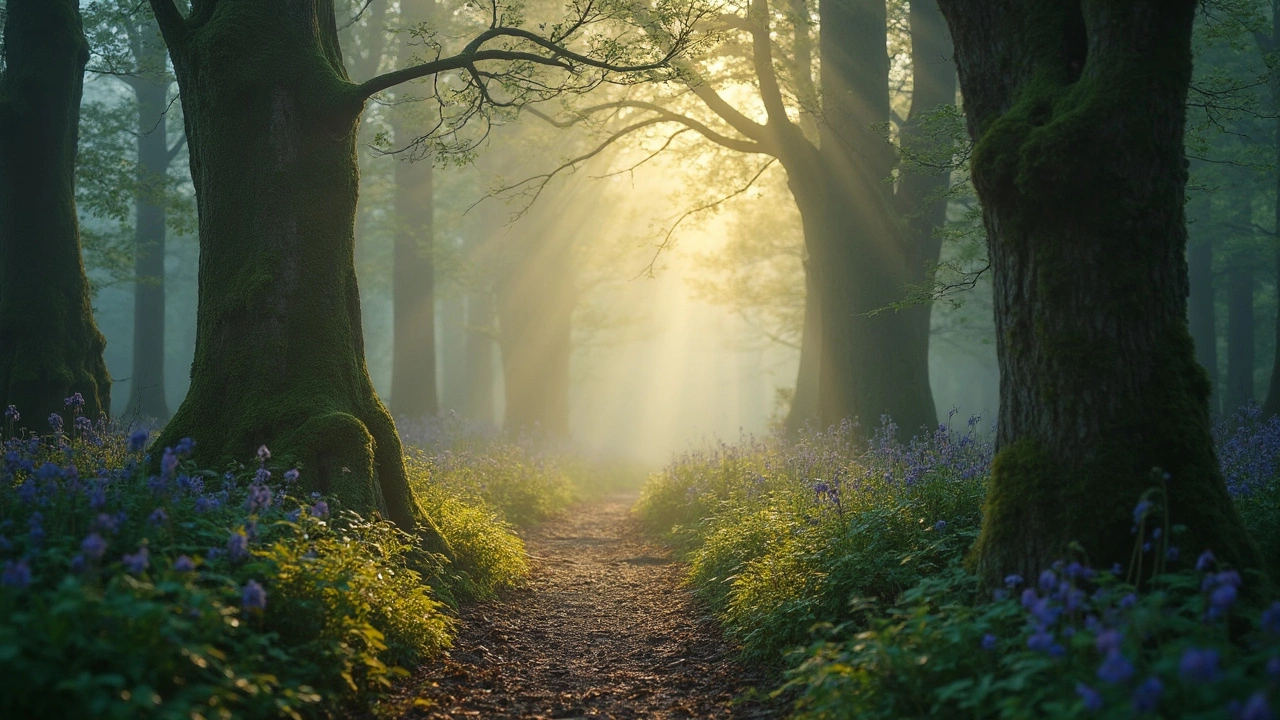If you think 'magical places in the UK' just means Stonehenge or Edinburgh Castle, you’re missing out. Magic here is often off the main road, tucked away in crooked villages, mossy forests, or places with stories older than the country itself. Sure, everyone loves a dramatic castle, but real magic hits when you stumble on a stone circle at sunrise, or lose yourself in a village that looks straight out of a children’s book.
One thing’s for sure—the UK isn’t short on enchantment. But the trick is knowing where to look, and when to go. Some places shine at dawn, others get their charm in the drizzle (good news: you’ll get plenty of that). And if you’re after crowd-free snaps for your socials, timing is everything. Early mornings and rainy afternoons often mean you get the place to yourself, just as the magic really starts to show.
Don’t just stick to the famous spots. Some of the best corners aren’t even marked clearly on most maps, but they’re often just a detour away from well-worn routes. Bring good shoes—mud is practically guaranteed in magical UK spots—and don’t forget a raincoat. Ready to discover where the real magic in the UK is hiding?
- What makes a place magical?
- The ancient mystery of Avebury
- Lost in the woodlands: Puzzlewood
- Village charm: Bibury and its secret corners
- Isle of Skye’s otherworldly landscapes
- How to squeeze the magic out of your UK trip
What makes a place magical?
So, what exactly turns an ordinary spot into something magical? It usually comes down to three things: the look of the place, the stories tied to it, and that feeling you get when you stand there. Magical places UK searchers always want somewhere that impresses with both looks and vibe.
A place gets extra points if it's got a weird or mysterious history. Think about Puzzlewood in the Forest of Dean—people say Tolkien got his ideas for Middle-earth here. Same with the stone circles at Avebury and Stonehenge. Both places make you want to know: who actually built this, and why? Not knowing the whole story is part of the fun.
Then there’s nature: ancient oaks, wild bluebells, thick morning fog. They mess with your sense of time. Some spots, like the Isle of Skye, look so unreal in person you actually wonder if you’re still in the UK.
- Easy to access but not overrun with tourists
- Strong links to old legends or myths
- Unique landscapes or hidden features
- Atmosphere that changes with the weather—rain can make a place way more dramatic
- No phone signal or traffic noise (seriously, silence feels magical after city life)
According to a VisitBritain survey, 42% of travelers list landscapes, history, and "quirky vibes" as their main reasons for exploring outside London. That explains why people seek out forests, seaside caves, or villages with only one pub and a story about ghosts.
| Magical Feature | Why It Feels Magical |
|---|---|
| Ancient Ruins | Connect you to a long-lost world |
| Misty Forests | Hide surprises every few steps |
| Crumbling Castles | Let your mind run wild with old stories |
Keep in mind: it’s not about tricked-out tourist traps. It’s about those places where you look around and honestly feel like something special might happen. Those are the spots that will stick with you long after the trip is over.
The ancient mystery of Avebury
Most people hear “stone circles” and think of Stonehenge, but Avebury is actually the biggest one in the world. What’s wild is that you can walk right up to the stones, touch them, and even wander through the whole site without fences or entry fees. This village in Wiltshire sits smack in the middle of a 5,000-year-old stone circle—literally, there are houses, a pub, and even a church inside the ring.
No one knows exactly why Neolithic people built Avebury, and honestly, that’s part of the fun. Archaeologists believe it was a sacred site, maybe used for rituals or gatherings. The henge—the ditch and bank around the stones—makes the whole place feel a bit otherworldly. And there’s more than just the main circle: there are two more stone circles inside the big one, plus the mysterious West Kennet Avenue (rows of stones stretching for over a mile) and the nearby Silbury Hill, an ancient man-made mound that’s taller than many pyramids.
Visiting Avebury in the early morning or late afternoon is a smart move if you want the place nearly to yourself. There are no crowds like Stonehenge, and the vibe is much more chilled. Here’s what you shouldn’t miss:
- Walk the entire outer circle (it takes about an hour and gives you the best views of the stones and countryside).
- Pop in the tiny, old-fashioned Red Lion pub—yes, it’s inside the stone circle!
- Check out the Alexander Keiller Museum for cool facts and surprising finds dug up on site.
- If you’re up for a walk, follow the West Kennet Avenue or wander to Silbury Hill—both are less than 30 minutes away on foot.
Pro tip: Avebury is open now more than ever for curious visitors who want something more hands-on than just snapping photos at a distance. This is one of those magical places UK travelers whisper about but rarely overcrowd, so you can enjoy a real connection to history, nature, and mystery all in one go.
Lost in the woodlands: Puzzlewood
Puzzlewood in the Forest of Dean isn’t just another patch of trees—it’s one of those magical places UK has tucked away for anyone willing to wander a little off the beaten path. Spread over 14 acres, this ancient woodland is full of twisting paths, mossy boulders, and secret nooks that honestly feel made for adventure movies. You might recognize it from "Star Wars: The Force Awakens," "Doctor Who," and even "Merlin." Hollywood comes here when they need somewhere that looks totally unreal.
The paths here wind through weird limestone rock formations—locals call them “scowles”—and there are ancient trees tangled everywhere you look. Some are so old and gnarled, you can’t help but wonder how many stories they’ve seen. The forest floor is blanketed in ferns all year, and after a rain (which, let’s be real, is common), the place feels like another planet entirely.
If you’re thinking of heading there, here’s what you should know:
- Puzzlewood is open pretty much year-round but aim for weekday mornings if you want the best chance of wandering undisturbed.
- There’s a small entry fee—book tickets in advance online if you can, since it gets busy during holidays and sunny weekends.
- The paths can get surprisingly muddy and slippery, especially after rain. Wear shoes you don’t mind getting dirty.
- Keen on history? Puzzlewood has Roman history too—archaeologists have found evidence of Roman iron ore mining here.
- No dogs are allowed, since the woodland is a protected area for local wildlife.
One more tip: pack a snack or a flask of something warm, since there aren’t loads of places to buy food nearby. There are picnic tables by the entrance, which is handy for a chill lunch before you explore. And don’t rush—half the fun is wandering at your own pace, noticing all the tiny details, like how roots and rocks weave together. Kids and adults both end up feeling like explorers here, camera or no camera.

Village charm: Bibury and its secret corners
Bibury looks like a movie set, but it’s completely real and actually lives up to the hype. Tucked away in the Cotswolds, this is the place people picture when they think of English villages—stone cottages, trout streams, and wildflowers everywhere. William Morris once called Bibury "the most beautiful village in England." He wasn’t joking.
The main attraction in Bibury is Arlington Row, a string of tiny, 14th-century cottages that’s probably the most photographed scene in the Cotswolds. Fun fact: it’s even printed inside UK passports. While everyone crowds these cottages, most people skip the footpath that leads behind them, which gives a totally different view and is usually empty.
Want to dodge tourist groups? Head to the Bibury Trout Farm. It’s actually the oldest working trout farm in England (dating back to 1902), and you can feed fish or picnic by the river. They’ll even let you try fishing yourself. If you’re into wildlife, keep an eye out for kingfishers or herons skulking around the banks.
Arlington Mill, just a short walk from the Row, gets hardly any attention but used to run on water power. Sometimes you can spot vintage machinery through the windows. Across the lane, the Swan Hotel does a solid afternoon tea if you just need to rest your feet.
Bibury isn’t just about the famous postcard spots. Here are some insider tips for your visit:
- Arriving early (before 9 a.m.) almost guarantees you’ll have Arlington Row to yourself. The village can see up to 500,000 visitors a year, so timing is everything.
- Pop into St Mary’s Church—look for the ancient Saxon gravestone out back, which dates from the 8th century.
- Stay overnight if you can. Most tourists are gone by evening, and you’ll see the real, sleepy village come alive.
Check this table for some quick facts about Bibury:
| Fact | Detail |
|---|---|
| Location | Cotswolds, Gloucestershire |
| Distance from London | Approximately 80 miles (130km) |
| Population | About 600 residents |
| Main attraction | Arlington Row |
| Best time to visit | Weekday mornings (avoid weekends and mid-day) |
Want to snap that dreamy village photo? Just wander off the main street and you’ll find quieter corners just as magical as the famous Row. That’s the real charm—getting away from the crowds and discovering the hidden bits only locals know about. For pure magical places UK vibes, Bibury’s secret corners are hard to beat.
Isle of Skye’s otherworldly landscapes
If you're serious about finding the magical places UK is known for, nothing really tops the Isle of Skye. Here, you’ll see mountains that look ripped out of fantasy movies, waterfalls pouring over cliffs, and villages where sheep seem to outnumber people at least five to one.
Let’s talk specific spots. The Quiraing is a must—giant green ridges, strange rock shapes, and sometimes a mist that rolls in and makes everything look wild. A hike here is about 6.8km if you do the circular route, and even folks who don’t love walking say it’s worth every step. Pack layers because the weather can change five times before lunch.
Then there’s the Fairy Pools, super famous on Instagram but they really do live up to the hype. Crystal-clear blue water flows down a series of waterfalls at the foot of the Black Cuillin mountains. Bring waterproof boots—the path can be boggy, and peak visiting months (June-August) get crowded by mid-morning, so aim for early or late in the day. Brave swimmers take a dip, but honestly, it’s freezing even in summer.
The Old Man of Storr is another must-see. It’s just north of Portree, the island’s main town, and is about 3.8km round trip. The rock needle is famous for being in movies like Prometheus and The Wicker Man, so don’t expect to have the trail all to yourself. Still, sunrise up here? Absolutely unreal views of the sea and little lochs below.
Getting to Skye is easy by car, thanks to the bridge from the mainland. There are buses, but they’re not super frequent, especially on Sundays. If you want to save money, book accommodation early because summer gets booked out fast. And if you’re there in winter, roads get icy but the landscapes are at their wildest and most empty.
| Spot | Best Time to Visit | Distance (km) |
|---|---|---|
| Quiraing | May-September (early morning) | 6.8 |
| Fairy Pools | April-June, September (late afternoon) | 2.4 |
| Old Man of Storr | Year-round (sunrise for best light) | 3.8 |
Most visitors leave Skye wishing they’d stayed longer, and not just for the scenery. The island vibe is super chill—people actually wave from their cars, and you might end up chatting with locals in a tiny café about the weather, old legends, or where to find the best homemade shortbread. It’s easy to see why this place tops so many UK wish lists for a reason.
How to Squeeze the Magic Out of Your UK Trip
If you want to make your UK trip feel truly magical, you need to do more than follow a guided tour or hop between famous landmarks. The trick is to blend planning with the freedom to go off-script. Here’s how you can get the most from your visit and really soak up those magical places UK vibes.
- Chase the soft light. Early morning and late afternoon are when the UK’s scenery glows. Sites like Puzzlewood or the Isle of Skye feel a notch more enchanting with a bit of mist or golden sunlight. Sunrise at Avebury or a foggy stroll by Bibury's river can make even a regular selfie look unreal.
- Go local, eat local. Big-name spots attract big crowds, but tiny market towns and village pubs often serve up the best food, friendliest chats, and less touristy charm. Try apple cider in Somerset or order a Cornish pasty straight from a bakery in Cornwall. Locals know the best walks and secret viewpoints, so ask them.
- Pack for rain, not regret. Average UK rainfall varies a lot—from 600mm in London to over 3,000mm a year on the west coast (yep, that’s real). Waterproofs, a decent pair of shoes, and layers are essential. A surprise rainstorm won’t ruin your magical trip if you come prepared.
- Take the train… or better yet, a bus. The UK’s public transport isn’t perfect, but some of the best views happen from a train window—like the ride to Fort William or the trip along the Cotswolds line. Buses often wind through the most rural, picturesque places and cost a fraction of renting a car.
- Check opening times and book early. Some hidden gems, like certain National Trust gardens or stone circles, have odd opening hours or small visitor limits. Always check ahead if there’s somewhere you’re dying to see, especially in peak months (July and August).
- Skip peak crowds. Even Britain’s top wonders feel flat when you’re shoulder-to-shoulder with a busload of tourists. Plan your visit outside of school holidays (mid-July to early September) or go for evening and mid-week trips. You’ll actually hear the birds—or the legends—without background chatter.
Here’s a quick look at when and where UK sights are at their peaceful best:
| Place | Best Time to Visit | Why? |
|---|---|---|
| Puzzlewood, Forest of Dean | 8-10am (Spring/Autumn weekdays) | Low crowds, magical morning mist |
| Bibury, Cotswolds | September (early morning) | Fewer tourists, colourful foliage |
| Avebury Stone Circle | Late Spring | Long days, clear sunrises |
| Isle of Skye | May or early June | Dry weather, wildflowers, less midges |
Booking ahead for stays in smaller spots is crucial. Remote villages and national parks fill up fast, especially in summer. Camping? Even wilder! You can camp on much of Scotland’s land thanks to the Scottish Outdoor Access Code, but double-check local restrictions. For totally unique stays, there’s everything from shepherd’s huts to old railway carriages—just book before everyone else catches on.
And save room for surprises. Give yourself a few hours target-free where you just wander, ask strangers for tips, or follow a path that looks interesting. You might stumble across a mini stone circle, a pop-up farm market, or a riverbank picnic spot with zero crowds. Sometimes, that’s where the magic really happens.










